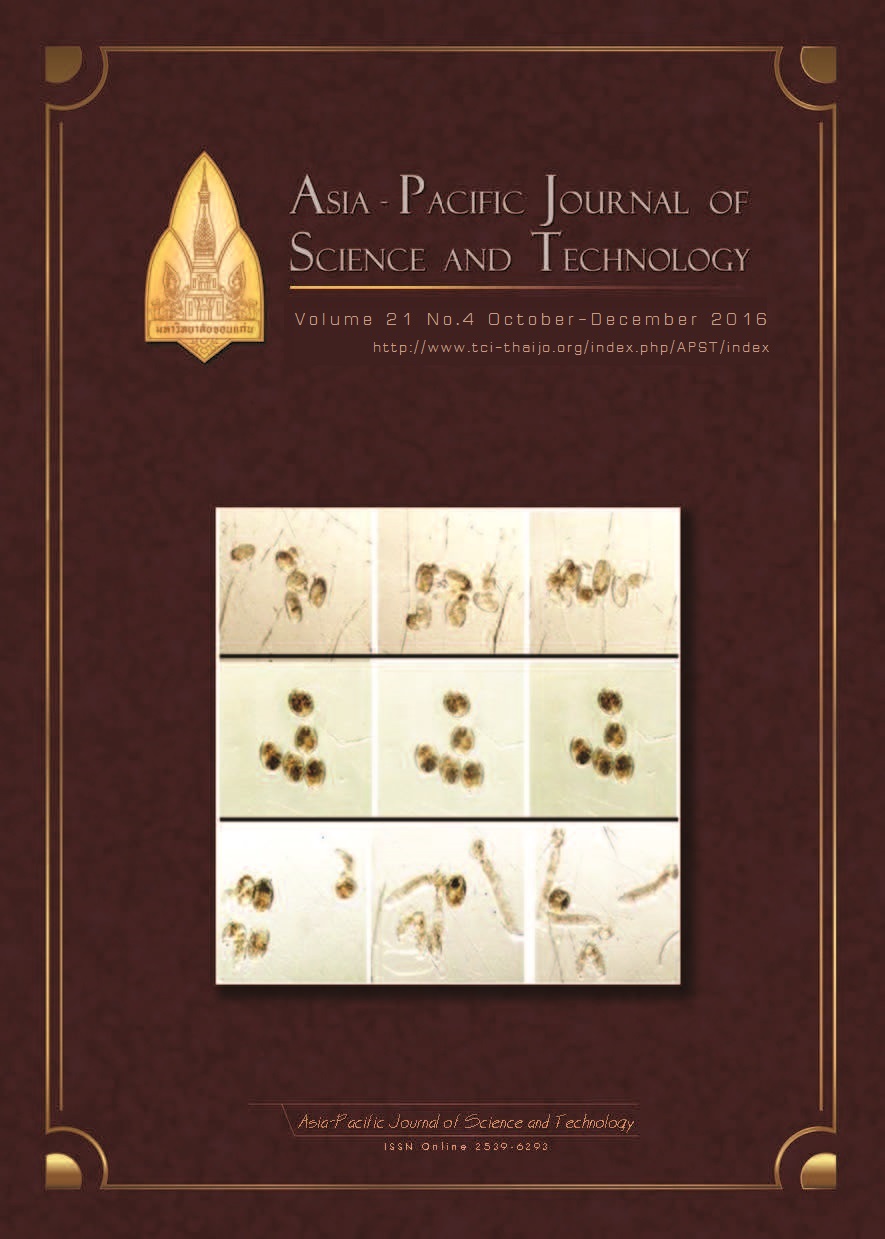Histopathological effects of Camellia oleifera seed and Garcinia mangostana pericarp extracts on Pomacea canaliculata snails, an intermediate host for Angiostrongylus cantonesis
Main Article Content
Abstract
We examined the histopathological changes in the tissues of Pomacea canaliculata snails incubated in crude extract obtained from camellia (Camellia oleifera) seed and mangosteen (Garcinia mangostana) pericarp, to evaluate the molluscicidal activity of these two plant substances. P. canaliculata snails were incubated in various concentrations of each plant extract for 24 hours. As a positive control, another group of snails was incubated in various concentrations of niclosamide solution, a chemical molluscicide. Similar histopathological findings were observed in both experimental and control snails. Both C. oleifera seed and G. mangostana pericarp extracts showed molluscicidal effects after 24 hours, with 50% and 90% lethal concentrations (LC50 and LC90) of 0.001 and 0.073 g/ml for C. oleifera, 0.001 and 0.024 g/ml for G. mangostana, and 0.659 and 3.397 ppm for niclosamide. Histopathological changes included alterations in the epithelial lining of the digestive tract, digestive gland, gill and foot. Loss of cilia, degeneration of columnar epithelial cells, and increased mucus vacuoles and cells were observed in the digestive tract and gill, while the digestive gland exhibited an increase in the number of dark granules and basophilic cells and dilation of digestive cells. The muscle cells of the foot had a loss of texture. The present findings indicate that both C. oleifera seed and G. mangostana pericarp have molluscicidal activity that could be used to control P. canaliculata.
Article Details
References
[2] Halwart, M., 1994. The golden apple snail Pomacea canaliculata in Asian rice farming systems: present impact and future threat. International Journal of Pest Management 40, 199-206.
[3] Wang, Q.P., Wu, Z.D., Wei, J., Owen, R.L., Lun, Z.R., 2012. Human Angiostrongylus cantonensis: an update. European Journal of Clinical Microbiology & Infectious Diseases 31, 389-395.
[4] Accorsi, A., Bucci, L., de Eguileor, M., Ottaviani, E., Malagoli, D., 2013. Comparative analysis of circulating hemocytes of the freshwater snail Pomacea canaliculata. Fish and Shellfish Immunology 34, 1260-1268.
[5] Kliks, M.M., Palumbo, N.E., 1992. Eosinophilic meningitis beyond the Pacific Basin: the global dispersal of a peridomestic zoonosis caused by Angiostrongylus cantonensis, the nematode lungworm of rats. Social Science & Medicine 34, 199-212.
[6] Moreira, V.L.C., Giese, E.G., Melo, F.T.V., Simões, R.O., Thiengo, S.C., Maldonado, A., Santos, J.N., 2013. Endemic angiostrongyliasis in the Brazilian Amazon: natural parasitism of Angiostrongylus cantonensis in Rattus rattus and R. norvegicus, and sympatric giant African land snails, Achatina fulica. Acta Tropica 125, 90–97.
[7] Wei, J., Wu, F., He, A., Zeng, X., Ouyang, L., Liu, M., Zheng, H., Lei, W., Wu, Z., Lv, Z., 2015. Microglia activation: one of the checkpoints in the CNS inflammation caused by Angiostrongylus cantonensis infection in rodent model. Parasitology Research 114, 3247–3254.
[8] Kim, J.R., Hayes, K.A., Yeung, N.W., Cowie, R.H., 2013. Definitive, Intermediate, Paratenic, and Accidental Hosts of Angiostrongylus cantonensis and its Molluscan Intermediate Hosts in Hawai‘i. Hawai'i Journal of Medicine & Public Health 72, 10.
[9] Al-Zanbagi, N.A., Barrett, J., Banaja, A., 2001. Laboratory evaluation of the molluscicidal properties of some Saudi Arabian euphorbiales against Biomphalaria pfeifferi. Acta Tropica 78, 23–29.
[10] Kaewjam, R.S., 1986. The apple snails of Thailand: distribution, habitats and shell morphology. Malacological Review, 61-81.
[11] Giacomin, M., Jorge, M.B., Bianchini, A., 2014. Effects of copper exposure on the energy metabolism in juveniles of the marine clam Mesodesma mactroides. Aquatic Toxicology (Amsterdam, Netherlands) 152, 30–37.
[12] Sawasdee, B., Köhler, H.-R., 2010. Metal sensitivity of the embryonic development of the ramshorn snail Marisa cornuarietis (Prosobranchia). Ecotoxicology (London, England) 19, 1487–1495.
[13] Tanhan, P., Sretarugsa, P., Pokethitiyook, P., Kruatrachue, M., Upatham, E.S., 2005. Histopathological alterations in the edible snail, Babylonia areolata (spotted babylon), in acute and subchronic cadmium poisoning. Environmental Toxicology 20, 142–149.
[14] Zarai, Z., Boulais, N., Marcorelles, P., Gobin, E., Bezzine, S., Mejdoub, H., Gargouri, Y., 2011. Immunohistochemical localization of hepatopancreatic phospholipase in gastropods mollusc, Littorina littorea and Buccinum undatum digestive cells. Lipids in Health and Disease 10, 219.
[15] Godoy, M.S., Castro-Vazquez, A., Castro-Vasquez, A., Vega, I.A., 2013. Endosymbiotic and host proteases in the digestive tract of the invasive snail Pomacea canaliculata: diversity, origin and characterization. PLoS ONE 8, e66689.
[16] Li, X., Jia, L., Zhao, Y., Wang, Q., Cheng, Y., 2009. Seasonal bioconcentration of heavy metals in Onchidium struma (Gastropoda: Pulmonata) from Chongming Island, the Yangtze Estuary, China. Journal of Environmental Sciences (China) 21, 255–262.
[17] Kruatrachue, M., Sumritdee, C., Pokethitiyook, P., Singhakaew, S., 2011. Histopathological effects of contaminated sediments on golden apple snail (Pomacea canaliculata, Lamarck 1822). Bulletin of Environmental Contamination and Toxicology 86, 610–614.
[18] Osterauer, R., Köhler, H.-R., Triebskorn, R., 2010. Histopathological alterations and induction of hsp70 in ramshorn snail (Marisa cornuarietis) and zebrafish (Danio rerio) embryos after exposure to PtCl(2). Aquatic Toxicology (Amsterdam, Netherlands) 99, 100–107.
[19] Cengiz, E.I., Yildirim, M.Z., Otludil, B., Unlü, E., 2005. Histopathological effects of Thiodan on the freshwater snail, Galba truncatula (gastropoda, pulmonata). Journal of applied toxicology: JAT 25, 464–469.
[20] Lama, J.L., Bell, R.A.V., Storey, K.B., 2013. Hexokinase regulation in the hepatopancreas and foot muscle of the anoxia-tolerant marine mollusc. Comparative Biochemistry and Physiology - Part B: Biochemistry & Molecular Biology 166, 109-16.
[21] Jonnalagadda, P.R., Rao, B.P., 1996. Histopathological changes induced by specific pesticides on some tissues of the fresh water snail, Bellamya dissimilis Müller. Bulletin of Environmental Contamination and Toxicology 57, 648–654.


